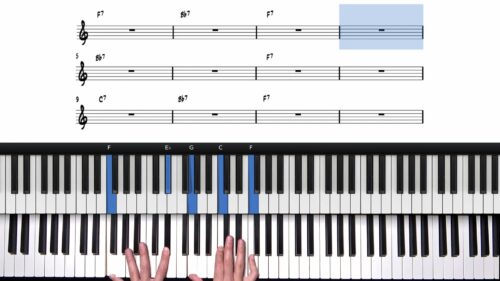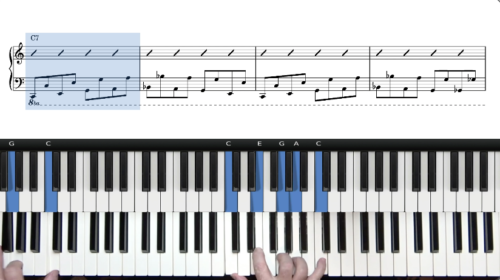Walk-ups & Walk-downs in Blues Piano
In this lesson we delve into walk-ups and walk-downs for the 12 bar blues progression in C. These movements add fluidity and complexity to our playing, making the transitions between chords smoother and more harmonically interesting.
Understanding Walk-ups and Walk-downs
Walk-ups and walk-downs are sequences of chords that bridge the gaps between the primary chords in a blues progression. These sequences of chords create a sense of movement and anticipation. They can be chromatic, diatonic, and often a mixture of both chromatic and diatonic root movement.
Starting with a basic walk-up from the I to the IV chord, we explore various voicings and left hand configurations whilst maintaining a consistent note on top which can also be referred to as a ‘drone note’.
Numeric Harmony & 251 Sequences
Incorporating walk-ups and walk-downs into our blues playing requires an understanding of the underlying harmony and the ability to visualise step-wise and chromatic bass line movements.
We highlight the similarities between passing chords and walk-downs. We can turn most passing chords into a walk-down sequence by adding an additional chord a half step above the passing chord. The additional chord can be a ii-7 chord, or alternatively a II7 chord which creates a descending chain of dominant chords.
We also explore walk-up phrases that utilise diminished chords, namely C to D- to Ebdim7 to C/E to F7. This walk up phrase can be used anytime that the underlying harmony moves from C7 to F7.
Practice Tips
-
Consistent Melody Notes: Experiment with maintaining a consistent melody note or 'drone note' on top throughout your walk-ups and walk-downs. For the 12 bar blues in C, the note "C" works well.
-
Left-Hand Options: Experiment with different left hand configurations such as octaves, shells, and 10th intervals. Also experiment with single note bass lines embellished with grace notes.
-
Repetition for Mastery: Regularly practice these walk-ups and walk-downs in different registers to internalise the movements and build muscle memory through the harmonic sequences.
- Slow and Steady: Start practicing walk-ups and walk-downs slowly, then gradually increasing the tempo as you become more comfortable with the movements and transitions.






